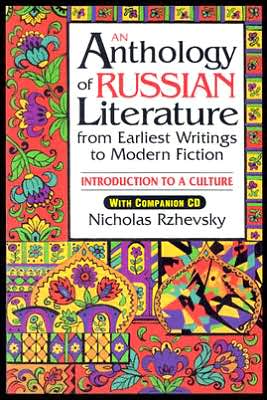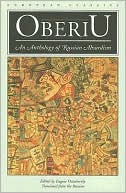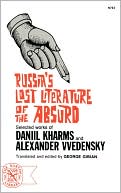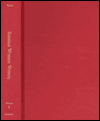Politicizing Magic: An Anthology of Russian and Soviet Fairy Tales
A compendium of folkloric, literary, and critical texts that show how the Russian fairy tale acquired political and historical meanings during the Soviet era\ We were born to make fairy tales come true. As one of Stalinism's more memorable slogans, this one suggests that the fairy tale figured in Soviet culture as far more than a category of children's literature. How much more-and how cannily Russian fairy tales reflect and interpret Soviet culture, especially in its utopian...
Search in google:
A compendium of folkloric, literary, and critical texts that show how the Russian fairy tale acquired political and historical meanings during the Soviet eraWe were born to make fairy tales come true. As one of Stalinism's more memorable slogans, this one suggests that the fairy tale figured in Soviet culture as far more than a category of children's literature. How much more-and how cannily Russian fairy tales reflect and interpret Soviet culture, especially in its utopian ambitions-becomes clear for the first time in Politicizing Magic, a compendium of folkloric, literary, and critical texts that demonstrate the degree to which ancient fairy-tale fantasies acquired political and historical meanings during the catastrophic twentieth century. Introducing Western readers to the most representative texts of Russian folkloric and literary tales, this book documents a rich exploration of this colorful genre through all periods of Soviet literary production (1920-1985) by authors with varied political and aesthetic allegiances. Here are traditional Russian folkloric tales and transformations of these tales that, adopting the didacticism of Soviet ideology, proved significant for the official discourse of Socialist Realism. Here, too, are narratives produced during the same era that use the fairy-tale paradigm as a deconstructive device aimed at the very underpinnings of the Soviet system. The editors' introductory essays acquaint readers with the fairy-tale paradigm and the permutations it underwent within the utopian dream of Soviet culture, deftly placing each-from traditional folklore to fairy tales of Socialist Realism, to real-life events recast as fairy tales for ironiceffect-in its literary, historical, and political context.
Politicizing Magic\ An Anthology of Russian and Soviet Fairy Tales \ \ \ NORTHWESTERN UNIVERSITY PRESS \ Copyright © 2005 \ Northwestern University Press\ All right reserved.\ \ ISBN: 978-0-8101-2032-7 \ \ \ \ \ Chapter One Folkloric Fairy Tales \ INTRODUCTION\ * * *\ Helena Goscilo\ PERENNIAL YET MYSTERIOUS ENCHANTMENT\ The abiding and universal appeal of folkloric fairy tales poses a cultural enigma: do these brief, indefatigably repeated narratives seduce the imagination through magic, fantasy, and vivid, unforgettable personae as a pleasurable mode of escapism? Or do they fulfill a pragmatic function, positing practical solutions (assimilated via unconscious identification) to typical psychological dilemmas firmly grounded in everyday experience? Are fairy tales fanciful flights providing respite from, and wishful compensation for, lived reality-or are they a fundamental part of that very reality, couched in symbolic form? Whether exercising the mysterious lure of conjury, illuminating mythic origins, or functioning as paradigmatic keys to problems, to what extent do fairy tales reflect the ethos and social mores of the cultures that produce them? Whom does their presumed audience comprise? In short, what do fairy tales strive for by endlessly iterating a minuscule number of predictable plots in multiple guises? If they have a more profound and submerged agenda than mere entertainment, what is that agenda and may it be generalized across generations and cultures?\ Perhaps the most striking aspect of folkloric fairy tales, and one that urges interpretation, is the complete absence of "depth" and of even rudimentary analysis within the tales themselves. Unlike literary fiction, they eschew explicit psychology and motivation; rely on a minimal, paratactic style; usually proceed as a series of actions indifferent to logical causation yet relentless in their teleological drive; combine supernatural, fantastic events and transformations with banalities and mechanical repetition of set phrases and situations; and cap dispassionately reported scenes of mayhem, inconceivable cruelty, and violence with a formulaic happy ending-the obligatory utopian closure that allies the genre with totalitarian scenarios of a secular paradise. Such flagrant contradictions and heterogeneity invite readers to elaborate some coherent hermeneutical model capable of accounting for these glaringly incompatible extremes. Indeed, the gratifyingly ample range of approaches advocated by both Western and Slavic scholars over many decades pays homage to the cryptic richness of the fairy-tale genre, while simultaneously complicating the most basic issues it invariably raises.\ INJUNCTIONS TO INTERPRETATION\ By now a classic of Russian structuralism and folkloric scholarship, Vladimir Propp's rigorously systematic Morphology of the Folktale (1928) inventories the motifs that organize the fairy-tale plot and, with impeccable logic, charts their immutable sequence. Scrupulously confining himself to classification, Propp on principle ignores the significance of the tales' contents. While invaluable for revealing the formal consistency of tales, Morphology (subsequently refined upon by E. M. Meletinsky) categorically dismisses any attempt to illuminate what fairy tales are about and why they beguile children more potently and enduringly than any other genre. Max Lüthi's formalist European Folktale (1947) extends Propp's paradigm to posit a stylistic model of the genre, which Lüthi, however, conceives as literary. Identifying one-dimensionality, depthlessness, abstract style, isolation, and universal interconnection, in addition to sublimation and all-inclusiveness, as the fairy tale's constitutive features (Lüthi 4-80), Lüthi ascribes wish fulfillment to the genre on a profound spiritual level (81-106). Such an approach to the genre neatly explains the wholesale Soviet adoption of fairy-tale topoi for its portrayal of a constantly deferred "radiant future" that never eventuates in reality and therefore requires hyperbolic compensatory power in the rhetoric of its cultural texts.\ Precisely where Propp and such early structuralists as A. Nikiforov fall (or stop) short, Bruno Bettelheim's Uses of Enchantment (1975), a famous psychoanalytical investigation mainly of French and German versions of fairy tales, offers bounties. Occasionally mechanistic, arbitrary, and overdetermined, Bettelheim's study advances a content-based thesis. Fairy tales, he riskily maintains, grapple with the integration of human personality and inscribe immemorial rites of passage rooted primarily, though not exclusively, in sexuality. Controversial and recently discredited partly because of Richard Pollack's "exposé" biography of its author, The Uses of Enchantment nonetheless is obligatory reading for specialists in fairy tales, whatever their resistance to neo-Freudianism. The Freudian concepts espoused by Bettelheim have enormous explanatory power, especially in light of the centrality accorded family and familial relations within the genre. Fairy tales, he contends, captivate children because they facilitate their maturation, subliminally furnishing ways of negotiating the ostensibly insurmountable psychological obstacles that confront them in an alienatingly adult world. How fairy tales accomplish this feat Bettelheim illustrates with copious exegetical examples. What Bettelheim fails to elucidate, and apparently finds irrelevant, is the appeal of fairy tales to adults-a blinkered omission that casts a certain naïveté over the study, which presupposes a fairy-tale readership primarily of children. In light of the sustained, large-scale Soviet co-optation of fairy-tale formulas, his perspective lacks historicity-unless, of course, one summarily concludes that Soviet culture was perpetually arrested at an infantile stage.\ The conviction that fairy tales symbolically inscribe psychic phenomena likewise underpins Jungian readings, from Marie-Louise von Franz's Interpretation of Fairy Tales (1970) to Clarissa Pinkola Estés's Women Who Run with the Wolves (1992) and The Maiden King by Robert Bly and Marion Woodman (1998). These critics, however, transfer the emphasis from sexuality to spirituality. Guided by Jung's essay "The Phenomenology of the Spirit in Fairy Tales," they focus on archetypes of the collective unconscious as manifested in the figures and patterns of the tales. This approach to the genre proves uncommonly productive for readers of Soviet texts structured around the genre's paradigms, as attested by Mark Lipovetsky's introduction to the third part of this collection.\ Readers skeptical of psychological approaches to folklore have found Jack Zipes, indisputably the most prolific Western scholar of fairy tales, a more congenial explicator of the genre's import, primarily along lines of power politics. Zipes's sociohistorical analytical model takes into consideration not only cultural production and dissemination, but also gender and class. Examining the ideological components of fairy tales, Zipes, as an adherent of the Frankfurt school, unsurprisingly contends that ever since the late seventeenth century the self-serving interests of the dominant class (first aristocracy, then bourgeoisie) have undermined the subversive potential of the genuinely popular (i.e., folk) fairy tale through appropriatory revision. Zipes's neo-Marxist treatment of the genre tends to reduce consumers of fairy tales to involuntary collaborators with a political elite that is empowered to propagate class-marked values via its control of cultural production-a position consonant with the dynamics between tyrannical victimizer and victim inscribed in Yevgeny Shvarts's fairy-tale play The Dragon. Whereas Bettelheim (berated by Zipes for moralism and the misrepresentation of Freud) spotlights children as intuitive readers, Zipes dissects "authors" as ideologues determined to socialize children forcibly in their own image. Arkady Gaidar's "Tale of the Military Secret" certainly lends credibility to such a view of authorial motivation, as noted in Marina Balina's introduction to the second part of the present volume.\ Zipes's concerns overlap with those of feminists such as Marcia Lieberman, Karen Rowe, Sandra Gilbert, Susan Gubar, and, to a lesser extent, Ruth B. Bottigheimer, who diagnose fairy tales as symptoms of their cultures' misogynistic traditions. For feminists, the fairy tales favored by a given society reflect its gender biases. Accordingly, Americans' Disney-abetted passion for "Cinderella," "Sleeping Beauty," "Snow White," and "Beauty and the Beast" testifies to our culture's expediently sexist projection of women as passively compliant, self-sacrificing, beauty-obsessed creatures devoid of agency. The inclusion of Russian fairy tales in Western feminists' sphere of reference would necessitate a modification of their critique, for, Russian society's notorious ageless sexism notwithstanding, some of Russia's favorite tales ("The Feather of Finist the Bright Falcon," "The Maiden Tsar," and "The Frog Princess") reverse the gender roles in the hackneyed paradigm that feminists deem generically quintessential.\ Unlike the majority of their Western counterparts, contemporary Russian folklorists continue to concentrate their scholarly energies on classification, typologies, and performers/tellers of tales (skaziteli). Decades ago, Alexander Afanasev, Pyotr Bogatyryov, and Roman Jakobson all emphasized the collective origins of the fairy tale, the latter two conceptualizing it as an evolving entity passed from generation to generation and subject to the prophylactic strictures of each community's shared values. Today, as then, such Russian specialists as Meletinsky essentially concur that a fairy tale "fulfills the role of a social utopia"(Jakobson 4:99) or, in Boris Sokolov's more mythological model, a dream compensation entailing, above all, the conquest of nature. These features of the fairy tale, of course, rendered it a genre supremely suited to the priorities of the Soviet Union's propaganda machine, which maximally exploited its miraculous and utopian attributes in virtually every cultural genre.\ Anglophone scholarship on the Russian fairy tale is relatively scant. Maria Kravchenko's highly readable World of the Russian Fairy Tale (1987) belongs to the historical trend in folkloristics, inasmuch as it seeks above all to establish the origins of the genre, principally in ancient rituals and beliefs. Jack Haney's slim monograph An Introduction to the Russian Folktale (1999)-part of an impressive multi-volume project-privileges description over analysis, relies heavily on earlier studies, and advances no original thesis. Haney's summary of the major tendencies in Russian compilation, classification, and interpretation (chapters 1 and 2) slights the modern period and does not assess the political benefits to the Soviet state of championing genuine folklore and particularly fakelore. Neither Kravchenko nor Haney grapples with the conundrum of the genre's colossal fascination for a young audience, an omission that indexes Anglophone Slavic folklorists' remoteness from current trends in Western scholarship.\ THE CANON\ Whereas Charles Perrault assembled the classic French collection of fairy tales in 1697, and the Grimm brothers followed suit with its German equivalent in 1812, what in modern times constitutes the standard Russian repertory appeared only in the mid-nineteenth century, compiled by Alexander Afanasev under the title of Popular Russian Fairy Tales (Narodnye russkie skazki, 1855-64). The approximately 600 tales in Afanasev's three-volume anthology represent an oral tradition familiar to all Russians-a limitless source for borrowings by High Culture, in particular music and literature, ever since its publication. The impressively vulgar tales expunged from the official edition, such as "The Magic Ring," which we include in the present volume, were printed later in, of all places, Geneva, Switzerland, and restored to Russia only after glasnost.\ As a living oral form, thus subject to multiple variations depending on the performance or recitation of the given work (and Afanasev's collection includes variants of individual tales),the traditional Russian fairy tale consists almost exclusively of fast-paced, plot-driven, formulaic narratives that pit mundane protagonists against apparently invincible enemies; resort to magic; incorporate proverbs, riddles, and verbal formulae; and end happily. The plots, characters, and motifs transcend national boundaries (i.e., the bulk of Russian tales are versions of narratives shared by western Europe), yet concrete details within fairy tales are endemic to Russia (e.g., Ivan the Fool lies on a Russian stove, the musical merchant Sadko strums the uniquely Russian guslia, the Russian bogatyrs [epic heroes] Ilya Muromets and Alyosha Popovich serve at Prince Vladimir's court, etc.). This apparent paradox accommodates both the universalizing models of feminist and psychoanalytical criticism, on the one hand, and on the other, the empirically oriented analyses of the anthropological and sociohistorical schools, which construct their arguments on the basis of particularized conditions in specific contexts. The most tenable approach to fairy tales, in my view, is synthetic, drawing on structuralism, psychology, feminism, and sociology. Social values, including notions of gender, shape mental habits both individually and collectively, while themselves simultaneously adjusting to the aesthetics of an established, if dynamic, genre as practiced in a concrete milieu. Accordingly, the most productive reading of fairy tales requires negotiation among several interpretive models that individually are over-inclined to totalizing strategies. The portion of Sandra Gilbert and Susan Gubar's Madwoman in the Attic (1979) devoted to an analysis of "Snow White" stands out as an exemplar of a synthetic, multilayered reading that opens up the tale in rewardingly provocative ways.\ THE PARADIGM\ Russian "magical" fairy tales, like those of most nations, unfold a quest or rite of passage as a colorful, improbable adventure: slaying a dragon; creating an entire city overnight; rescuing a princess from an evil, uncanny ogre; and so forth. The protagonist typically effects a watershed transition-from childhood to adolescence, from puberty to adulthood, from dependence to independence, from alienation to integration, from helplessness to control. The phenomenal effort expended on the central exploits (frequently cast as an exhausting journey) inevitably marks a new stage of life, which explains the frequency of marriage as an ultimate reward for triumph over adversity. Whether the surmounted hurdles be psychological (Bettelheim) or social (Zipes) or both (Gilbert and Gubar), fairy tales culminate in a victory over enemies and rivals achieved through a credulity-defying intermixture of ingenuity, sheer persistence, and fortuitously encountered magical resources.\ (Continues...)\ \ \ \ \ Excerpted from Politicizing Magic\ Copyright © 2005 by Northwestern University Press. Excerpted by permission.\ All rights reserved. No part of this excerpt may be reproduced or reprinted without permission in writing from the publisher.\ Excerpts are provided by Dial-A-Book Inc. solely for the personal use of visitors to this web site.\ \
Pt. IFolkloric fairy talesIntroduction5The frog princess23The three kingdoms28Baba Yaga32Vasilisa the beautiful34Maria Morevna42Tale of Prince Ivan, the firebird, and the gray wolf51The feather of Finist the bright falcon62The magic mirror69Danilo the luckless79Ilya Muromets and the dragon85The maiden tsar91The magic ring96Pt. IIFairy tales of socialist realismIntroduction105Tale of the military secret, Malchish-Kibalchish and his solemn word123The golden key, or the adventures of Buratino131The old genie Khottabych : a story of make-believe165The Malachite casket197The flower of seven colors222Pt. IIIFairy tales in critique of Soviet cultureIntroduction233Fairy tales for grown-up children251The dragon : a satiric fable in three acts267Tale of the Troika316Before the cock crows thrice345That very Munchausen381







